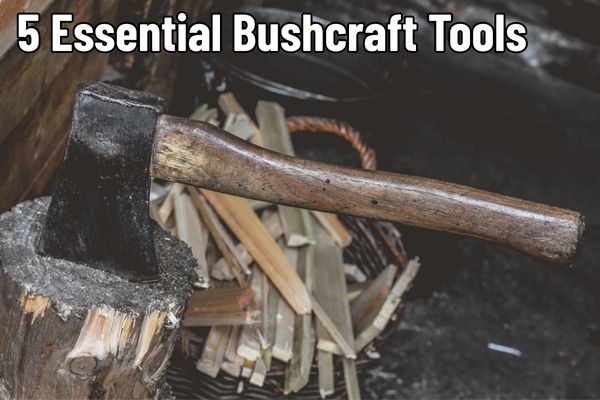When infrastructure fails and we must rely on our own skills and equipment, having the right bushcraft tools might mean the difference between life and death.
Whether preparing for a power outage or planning for long-term off-grid living, becoming familiar with these five essential tool categories will give you confidence and capability to handle whatever an emergency and nature throws your way.
These five tool categories form the foundation of any serious prepper’s survival kit, each serving multiple purposes while remaining portable enough for extended wilderness expeditions.
<1> The Survival Knife: Your Most Critical Tool
In any survival situation, your knife becomes a part of your body. It’s simultaneously a cutting tool, weapon, fire starter, food processor, and crafting implement. Do not skimp on a survival knife; a high quality knife is essential.
Best Brands and Models
Morakniv Garberg – Swedish craftsmanship at its finest, the Garberg features a full-tang carbon steel blade that holds an exceptional edge. At around $80, it offers professional-grade performance without breaking the bank. The 4.3-inch blade strikes the perfect balance between precision work and heavy-duty tasks.
ESEE-6 – Built by veterans for serious users, this 6-inch fixed blade knife can handle everything from food preparation to shelter construction. The 1095 carbon steel blade is virtually indestructible, and ESEE’s lifetime warranty demonstrates their confidence in the product’s durability.
Benchmade Bushcrafter 162 – For those willing to invest in premium American manufacturing, the Bushcrafter features S30V stainless steel and ergonomic handle design that reduces hand fatigue during extended use.
Practical Applications
Your survival knife serves countless functions beyond just cutting. Use it to cut through small logs—place the blade on top of the wood and strike the spine with a sturdy stick. The full-tang construction of quality knives allows them to withstand repeated impact without breaking.
For shelter construction, your knife becomes a precision tool for notching branches, stripping bark, and carving stakes. Create feather sticks for fire starting by making thin curls along a dry branch, leaving them attached to increase surface area for ignition.
Keep your knife sharp with stone or steel – a dull blade is dangerous because it requires more pressure and is more likely to slip. Clean and dry your knife after each use, especially if cutting acidic foods.
<2> The Hatchet: Power Tool for Heavy Work
While your knife handles precision tasks, a hatchet provides the raw power needed for shelter construction, firewood processing, and tool crafting. The weight of the head multiplies your striking force, making short work of tasks that would exhaust you with a knife alone.
Best Brands and Models
Gransfors Bruks Small Forest Axe – Handcrafted in Sweden, this 19-inch axe represents the pinnacle of traditional axe-making. Each axe is signed by its maker and comes sharp enough to shave with. The head geometry excels at both splitting and chopping, making it incredibly versatile.
Husqvarna Multipurpose Axe – Offering excellent value for the money, this Swedish-made axe features a forged steel head with optimal weight distribution. The hickory handle provides shock absorption while maintaining the feedback needed for accurate strikes.
Fiskars X15 Chopping Axe – Modern materials meet traditional design in this Finnish axe. The composite handle is virtually unbreakable and won’t loosen over time, while the ultra-sharp blade stays keen longer than traditional steel.
Practical Applications
Hatchet technique differs significantly from knife work – let the weight of the head do the work rather than muscling through cuts. For splitting kindling, aim for the edge of the wood rather than the center to create clean splits along the grain.
When felling small trees for shelter poles, cut at a 45-degree angle from both sides to create a V-shaped notch. This technique prevents the axe from sticking in the wood and provides better control over where the tree falls.
Always maintain a “blood circle” – an area around you equal to the length of the axe handle plus your arm span. Never let anyone enter this space while you’re working.
<3> The Folding Saw: Precision Cutting Power
A quality folding saw cuts faster and cleaner than a hatchet while remaining compact enough for easy carrying. The fine teeth create smooth cuts perfect for joints and detailed work, while the folding design protects both the blade and your gear during transport.
Best Brands and Models
Silky Gomboy 240 – Japanese engineering creates the sharpest, most efficient cutting action available. The aggressive tooth pattern cuts on the pull stroke, allowing for better control and less effort. The 9.5-inch blade handles everything from thumb-thick branches to 6-inch logs.
Bahco Laplander – Swedish design meets practical functionality in this affordable folding saw. The 7.5-inch blade cuts quickly through green and dry wood, while the comfortable handle reduces hand fatigue during extended use.
Corona RazorTooth RS 7265D – American-made durability with triple-cut teeth that slice through wood like butter. The 10-inch blade provides excellent reach while maintaining precise control for detailed work.
Practical Applications
Use your folding saw for cutting shelter poles to exact lengths – something nearly impossible with a hatchet. The fine kerf (cut width) wastes minimal material, important when every piece of wood counts in survival situations.
For trap construction, the saw creates clean cuts that don’t splinter, ensuring your mechanisms work smoothly. The saw excels at cutting green wood for tool handles, bow staves, and cooking implements.
Keep your saw blade clean of sap and debris that can clog the teeth and reduce cutting efficiency. Replace blades when they become dull – attempting to sharpen the complex tooth geometry typically ruins the cutting action.
<4> Multi-Tool: Versatility in Your Pocket
A quality multi-tool offers dozens of specialized functions in a compact package. While no single tool in a multi-tool matches the performance of a dedicated implement, the convenience of having pliers, screwdrivers, awls, and other tools instantly available makes multi-tools indispensable for field repairs and detailed work.
Best Brands and Models
Leatherman Wave Plus – The gold standard for full-size multi-tools, featuring 18 tools including locking knife blades, wire cutters, and both Phillips and flathead screwdrivers. The outside-accessible blades allow one-handed operation, crucial when your other hand is occupied.
Victorinox Swiss Army Huntsman – Classic Swiss engineering provides 15 functions in a slim, lightweight package. The selection includes scissors, saw, and leather awl along with the traditional blades and tools.
Gerber Center-Drive – Features a full-size driver bit that operates like a real screwdriver, providing much better torque than traditional multi-tool drivers.
Practical Applications
Use pliers for handling hot objects around the fire, straightening bent gear, and pulling thorns or splinters. The wire cutters trim snare wire and cut fishing line precisely. Small scissors handle tasks too delicate for your knife, like cutting tinder or trimming medical tape.
The awl punches holes in leather for repairs or lashings, while various screwdrivers maintain and adjust gear in the field. For trap making, use the small blade to carve delicate trigger mechanisms that require more precision than your main knife can provide.
Clean tools after use, especially if exposed to salt water or acidic substances. Oil pivot points periodically to maintain smooth operation.
<5> Shelter Gear: Your Mobile Base Camp
Quality shelter gear protects you from the elements while providing a comfortable base for other survival activities. Modern materials and designs offer lightweight solutions that pack small but provide reliable protection in extreme conditions.
Best Brands and Options
DD Hammocks SuperLight Tarp – This versatile shelter weighs just 1.3 pounds but provides 3×3 meter coverage. Multiple guy-out points allow dozens of setup configurations from simple lean-to to fully enclosed shelter.
Snugpak Ionosphere – A complete one-person shelter system combining groundsheet, inner tent, and outer shell. The design sheds rain and wind while providing protection from insects and ground moisture.
Aqua Quest Defender Tarp – Heavy-duty ripstop nylon with fully sealed seams creates bomber protection in extreme weather. Available in multiple sizes, the reinforced attachment points handle high winds without tearing.
Klymit Static V Insulated Sleeping Pad – R-value 4.4 insulation prevents heat loss to the ground while weighing just 25 ounces. The V-chamber design provides stable sleeping surface and packs smaller than traditional pads.
Setup and Applications
Familiarize yourself with multiple tarp configurations for different conditions. The simple A-frame provides excellent rain protection with minimal setup time. The lean-to configuration offers wind protection while allowing fire warmth to reach you.
Use natural features to enhance your shelter – position against large rocks or fallen logs for wind protection and extra insulation. Select campsites with natural drainage to avoid flooding during storms. Orient your shelter opening away from prevailing winds but positioned to catch morning sun.
Create ventilation even in enclosed shelters to prevent condensation buildup. Practice setup in good conditions so you can deploy quickly in emergencies.
Clean shelters before storage to prevent mold and mildew. Check seam sealing periodically and reapply as needed. Repair small tears immediately with tape or patches before they become major failures.
Building Your Bushcraft Arsenal
These five tool categories form the foundation of wilderness self-reliance. But remember that tools are only as good as the skills behind them. Invest time practicing with each one, learning its capabilities and limitations. Acquire quality tools rather than accumulating cheap gear that fails when you need it most.
The key to successful bushcraft lies not in having the most expensive equipment, but in understanding how to use reliable tools to meet your survival needs. Master these categories, and you’ll have the foundation to thrive in any wilderness situation.
Bushcraft is about knowledge, skills, and mindset. Tools enhance your capabilities, but your mind remains your most important survival asset. Practice regularly, maintain your gear, and prioritize safety over speed when learning new techniques.




